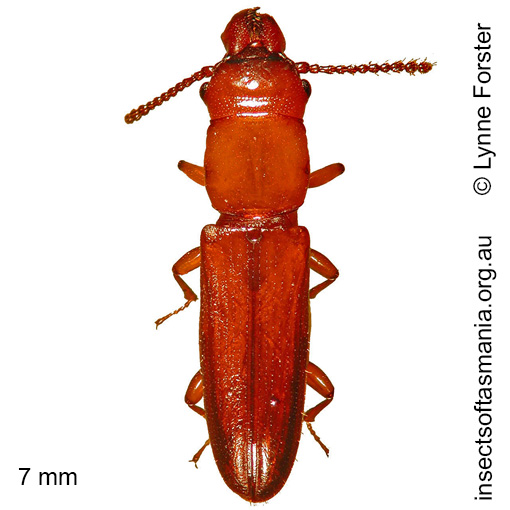
Prostomis atkinsoni Waterhouse, 1877 (a species of red log-beetle)
Basis for Tasmanian occurrence
Semmens, T.D., McQuillan, P.B. & Hayhurst, G. (1992). Catalogue of the Insects of Tasmania. Government of Tasmania: Department of Primary Industry, 104 pp. (as Prostomis atkinsoni)
TMAG collections
Classification
Order: Coleoptera
Suborder: Polyphaga
Superfamily: Tenebrionoidea
Family: Prostomidae
Morphology
Typical length (mm): 7
Flightedness: winged and assumed capable of flight
Morphology (characterised by L. Forster): — Antennae with third apical joint noticeably longer than second — Body flat, polished, glabrous — Head with fine punctures; jugular processes not visible from above; left jugular process longer than the right, with the tip dilated into a transverse tooth — Pronotum with very fine punctures and shallow, indistinct longitudinal furrow — Wings present.
Ecology
Assumed larval feeding: wood-feeder
Association with dead wood or old trees: obligately saproxylic
Ecological attributes: — Affiliated with older trees (Harrison, 2007) — Associated with brown discoloured wood (Yee et al., 2006) — Associated with brown rot in inner heartwood (Wardlaw et al., 2009) — Associated with combination pocked and brown rot (Harrison, 2007) — Associated with dry brown cubic rot (Harrison, 2007) — Associated with mudguts (Grove, 2007) — Associated with mudguts (Harrison, 2007) — Associated with mudguts (Yee et al., 2006) — Associated with red-brown blocky muddy rock (Yee et al., 2001) — Associated with red-brown soft blocky fibrous rot (Yee et al., 2006) — Associated with wet brown cubic rot (Harrison, 2007) — Found under large logs (Grove et al., 2006) — May occupy logs or trunks of Eucalyptus obliqua, at least temporarily, since found having emerged within a year of felling (Grove & Bashford, 2003) — May occupy logs or trunks of Eucalyptus obliqua, at least temporarily, since found having emerged within six years of felling (Grove et al., 2009).
Collection method(s) for TMAG material: — Baited trapping (funnel trap) — Emergence trapping from cut billets of Eucalyptus obliqua (Harrison, 2007) — Emergence trapping from log of Eucalyptus obliqua — Flight intercept trapping (trough below Malaise trap) — Hand collection (substrate not specified) — Hand collection from under log of Eucalyptus sp. — Malaise trapping — Pitfall trapping — Vane trapping.
Source ecological literature:
Grove, S.J. & Bashford, R. (2003). Beetle assemblages from the Warra log decay project: insights from the first year of sampling. Tasforests 14: 117-129.
Grove, S.J. (2009a). A decade of deadwoodology at Warra. Tas. Nat. 131: 25-35.
Grove, S.J. (2009b). Beetles and fuelwood harvesting: a retrospective study from Tasmania’s southern forests. Tasforests 18: 77-99.
Grove, S.J. et al. (2006). What lives under large logs in Tasmanian eucalypt forest? Tas. Nat. 128: 86-93.
Hopkins, A.J.M. et al. (2005). Wood decay fungi and beetle assemblages associated with living Eucalyptus obliqua trees: early results from studies at the Warra LTER Site, Ta
Wardlaw, T.J. et al. (2009). The uniqueness of habitats in old eucalypts: contrasting wood-decay fungi and saproxylic beetles of young and old eucalypts.Tasforests 18: 19-32
Yee, M. et al. (2001). Not just waste wood: decaying logs as key habitats …: the ecology of large and small logs compared. Tasforests 13: 119-128.
Baker, S.C. (2006b). Ecology and conservation of ground-dwelling beetles in managed wet eucalypt forest: edge and riparian effects. PhD thesis, Univ. of Tasmania, Hobart.
Grove, S. et al. (2009). A long-term experimental study of saproxylic beetle … succession in Tasmanian Eucalyptus … logs… In: Fattorini, S. (Ed.), Insect Ecology and Conservation. Research Signpost, pp. 71-114.
Grove, S.J. (2007). Mudguts.Tas. Nat. 129: 2-7.
Harrison, K.S. (2007). Saproxylic beetles associated with habitat features in Eucalyptus obliqua trees in the southern forests of Tasmania. PhD thesis, Dept. of Zoology, Univ. of Tasmania, Hobart.
Taylor, R.J. (1990). Occurrence of log-dwelling invertebrates in regeneration and oldgrowth wet sclerophyll forest in southern Tasmania. Pap. Proc. Roy. Soc. Tas. 124: 27-34.
Watson, S. (2003). Dispersal and gene flow in Prostomis atkinsoni (Coleoptera). Hons. thesis, LaTrobe Univ., Melbourne.
Yee, M. (2005). The ecology and habitat requirements of saproxylic beetles native to Tasmanian wet eucalypt forests: potential impacts of commercial forestry practices. PhD thesis, Univ. of Tasmania, Hobart.
Yee, M. et al. (2006). Brown rot in inner heartwood: why large logs support characteristic … beetle assemblages … In Grove, S.J. & Hanula, J.L. (eds.) Insect biodiv. and dead wood, pages 42-56. USDA For. Serv., SRS.





